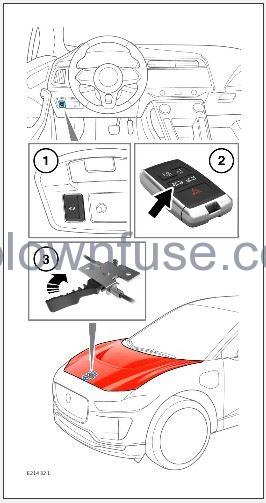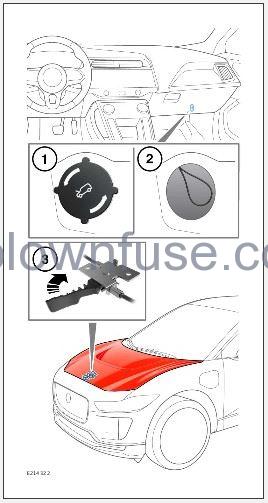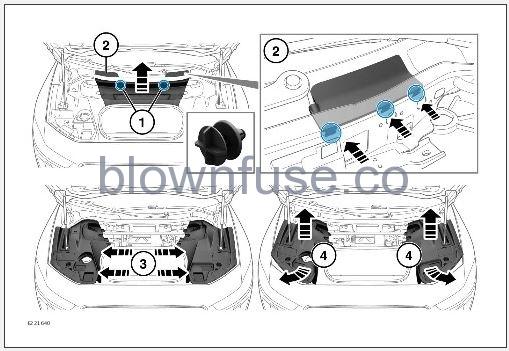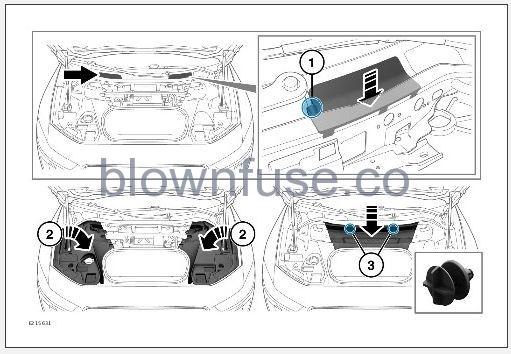 2023 JAGUAR I-PACE MAINTENANCE
2023 JAGUAR I-PACE MAINTENANCE

BREAKING-IN
The vehicle is built using high-precision manufacturing methods, but the moving parts of the electrical system must still bed-in, relative to each other. The bedding-in process occurs mainly in the first 3 000 km of operation.
During the running-in period of 3 000 km, observe and follow the instructions below:
- Do not fully press the accelerator pedal during starts and normal driving.
- Gradually increase road speeds.
- Avoid continuous operation at high speed and abrupt stops.
- Avoid frequent cold starts followed by short-distance driving.
- Preferably take longer journeys.
- Do not participate in track days, sports driving schools, or any similar events.
AIR CONDITIONING (A/C)
With reference to US legislation relating to Air Conditioning (A/C) refrigerants, J2845 Technician Training for Safe Service and Containment of Refrigerants Used in Mobile Air Conditioning (A/C) Systems (HFO-1234yf) states that under no circumstances should any part of the A/C system be serviced, dismantled, or replaced by anyone other than suitably qualified and certified personnel. Make sure that the refrigerant is correctly contained at all times. Failure to adhere to the above may result in serious personal injury or death.
All replacement parts for the Air Conditioning (A/C) system must be new and equivalent to the manufacturer’s original equipment. All replacement parts must comply with the relevant SAE standard (J2842). Contact a retailer/authorized repairer for advice. Failure to do so may lead to serious personal injury or death.
The following symbols may be used on an under-hood label and are relevant to the refrigerant fluid:

A/C symbol.

Lubricant symbol.
Caution.
Flammable refrigerant.
Required registered technician to service A/C.
Consult the Owner’s Handbook.
OWNER MAINTENANCE
Any significant or sudden drop in fluid levels, or uneven tire wear, should be reported to a qualified technician without delay. Failure to do so may damage the vehicle and lead to accidents, potentially resulting in serious injury or death.
In addition to the routine maintenance, a number of simple checks must be carried out more frequently. See DAILY CHECKS and WEEKLY CHECKS.
DAILY CHECKS
- Operation of the lights, horn, turn signals, wipers, washers, and warning lamps.
- Operation of the seat belts and brakes.
- Look for fluid deposits underneath the vehicle that might indicate a leak. Condensation drips from the Air Conditioning (A/C) system are normal.
WEEKLY CHECKS
Check the following every week:
- Coolant level.
- Brake fluid level.
- Screen washer fluid level.
- Tire pressures and condition.
- Operate the Air Conditioning (A/C).
STORING THE VEHICLE
Make sure that the high voltage battery is charged to a target of 30% and no more than 60%. Failure to do so may result in damage to the battery.
Make sure that the 12V battery remains connected, and in a sufficiently charged state, during the storage period.
In the event of long term storage, make sure to charge the high voltage battery every 30 days.
When charging the high voltage battery, it is recommended to connect the vehicle’s charging cable to an external charging station. While the battery is charged, the instrument panel displays the current high voltage battery charge level. See CONNECTING A CHARGING CABLE.
The current high voltage battery charge level can also be viewed in the instrument panel’s power gauge display. See INTERACTIVE DRIVER DISPLAY.
In extreme cold climate conditions, circa -22°F (-30°C), store the vehicle in a warmer area to protect it from the environment.
ANTI-THEFT SYSTEM
No modifications or additions should be made to the anti-theft system. Such changes could cause the system to malfunction, which increases the risk of theft.
AIRBAG SYSTEM
The components that make up the airbag system are sensitive to electrical or physical interference. Electrical and/or physical interference could easily damage the system and cause inadvertent operation or a malfunction of the airbag module. Airbags should only be repaired by an authorized repairer. If the air bags are not repaired correctly, they may not operate correctly during a collision, which may lead to serious injury or death.
To prevent malfunction of the airbag system, always consult a retailer/authorized repairer before fitting any of the following:
- Electronic equipment such as a mobile phone, two-way radio, or in-vehicle entertainment system.
- Accessories are attached to the front of the vehicle.
- Any modification to the front of the vehicle.
- Any modification involving the removal or repair of any wiring or component in the vicinity of any of the air bag system components. The components include the steering wheel, steering column, and instrument and dashboard panels.
- Any modification to the dashboard panels or steering wheel.
PARTS AND ACCESSORIES
Make sure the following warnings have been read and fully understood. Failure to comply with the safety instructions could result in an accident, leading to serious injury or death.
Fitting of non-approved parts and accessories, or the carrying out of non-approved alterations or conversions, may be dangerous and could affect the safety of the vehicle and occupants, and also invalidate the terms and conditions of the vehicle’s warranty. Jaguar Land Rover Limited will not accept any liability for death, personal injury, or damage to property, which may occur as a result of installation of non-approved accessories or the carrying out of non-approved conversions to the vehicle.
With reference to US legislation relating to Air Conditioning (A/C) refrigerants, J2845 Technician Training for Safe Service and Containment of Refrigerants Used in Mobile Air Conditioning (A/C) Systems (HFO-1234yf), states that under no circumstances should any part of the A/C system be serviced, dismantled, or replaced by anyone other than suitably qualified and certified personnel. Make sure that the refrigerant is correctly contained at all times.
All replacement parts for the Air Conditioning (A/C) system must be new and equivalent to the manufacturer’s original equipment. All replacement parts must comply with the relevant SAE Standard. Contact a retailer/authorized repairer for advice. Failure to adhere to the above may result in personal injury.
The following symbol may be used on an under-hood label and is relevant to the refrigerant fluid:

Extremely flammable. Chemicals that have an extremely low flash point and boiling point, and gases that catch fire when in contact with air.
ROAD TESTING DYNAMOMETERS (ROLLING ROADS)
Any dynamometer testing should only be carried out by a qualified person, familiar with the dynamometer testing and safety procedures practiced by retailers/authorized repairers.
SAFETY WHEN CARRYING OUT VEHICLE CHECKS
Make sure the following warnings have been read and fully understood before carrying out vehicle checks. Failure to follow the guidance given could affect vehicle safety, leading to serious injury or death.
Vehicle repairs should only be carried out by a suitably qualified technician.
If the vehicle has been driven recently, do not touch the cooling system components until the vehicle has cooled.
The jack is designed for wheel changing only. Never work beneath the vehicle with the jack as the only means of support. Always use correctly-rated vehicle support stands, before putting any part of the body beneath the vehicle.
Keep hands and clothing away from drive belts, pulleys, and fans. Some fans may continue to operate, or start operating, after the motor is switched off.
Do not allow tools or metal parts of the vehicle to make contact with the battery leads or terminals.
OPENING THE HOOD
Before opening the hood, make sure that the vehicle’s electrical system is switched off and the smart key is removed from the vehicle. Failure to do so can potentially result in serious injury or death.

To open the hood:
- Press the interior hood release button.
- Alternatively, press the remote hood release button on the remote key.
NOTES
Both the interior hood button and the remote hood release button only release the hood when the vehicle is unlocked. - Lift the hood safety catch. Raise the hood.

To open the hood with no power:
- Remove the cap located in the right front footwell by turning the it counter-clockwise.
- Pull the emergency release cord.
- Lift the hood safety catch. Raise the hood.
CLOSING THE HOOD
Before closing the hood, make sure that no-one is obstructing the closing area and that hands and clothes are clear. The closing hood may cause serious injuries.
Do not drive with the hood secured by the safety catch alone. If the hood opens while driving, it may lead to a collision, which may cause serious injuries or death.
When closing the hood, make sure to stand in front of the vehicle. Do not attempt to close the hood while standing at the side of the vehicle. Doing so may result in incorrect latching of the hood, which may cause serious injuries or death.
To close the hood:
- Using both hands, lower the hood and let it drop from a height of between 8 to 20 in (20 to 50 cm).
- Try to lift the front edge of the hood, near both corners, to check that it is securely engaged.
- If the hood lifts slightly, it is not properly latched. Open the hood again, and with a little more force, try again to close it.
UNDER-HOOD COVERS REMOVAL
High voltage cables may be exposed when removing the under-hood covers. Tampering with the high voltage system can cause severe burns or electric shock, which may result in serious injury or death. High voltage cables and connectors are colored orange for identification purposes.

To remove the under-hood covers:
- Unscrew the turnbuckle clips (1) counter-clockwise and remove the upper cover.
- Press the three clips in and remove the coolant and brake fluid reservoir covers.
NOTES
Access the three clips via the three holes located below the covers. - Gently pull the side covers, as illustrated, to release it from the luggage compartment.
- Lift and rotate the side covers clockwise to access the fuse box.
To prevent damage when moving the side covers, pay close attention to the position where the hood strut passes through the cover.
UNDER-HOOD COVERS REFITTING

To refit the under-hood covers:
- Locate the cover’s rear locating lugs into the vehicle’s panel and lightly press down the cover to engage the front securing clips into the vehicle’s panel.
CAUTION
To prevent damage when refitting the cover, make sure to route any fluid lines through the cut-out (1) provided. - Replace the two side covers.
- Replace the upper cover and turn the turnbuckle clips clockwise to secure the cover.
CHANGING A BULB
All lights are LED units and must only be replaced by a retailer/authorized repairer.
WIPERS SERVICE POSITION
To avoid damage to the hood, do not lift the wiper blades when they are in the normal parked position.
The smart key must remain in the vehicle while the wiper blades are replaced.
Fit only replacement wiper blades that are identical to the original specification.
Replace the wiper blades in accordance with the manufacturer’s instructions.
Before changing a wiper blade, the wiper arms must be set in the service position as follows:
- Make sure the vehicle’s electrical system is switched off.
- Switch the vehicle’s electrical system on and then off again.
- Immediately press the wash/wipe control to its lowest position, as if to command a single wipe. Hold this position while switching on the vehicle’s electrical system again. The wipers move to the service position. See WIPER OPERATION.
- When the new parts have been fitted, switch the vehicle’s electrical system off. The wipers return to the park position.
WINDOW RESET
The windows need to be reset if the battery is disconnected, becomes discharged, or the power supply is interrupted.
Once the power supply is restored, reset the windows as follows:
- Close the window fully.
- Release the switch. Lift it to the close position and hold for 2 seconds.
- Release the switch.
- Repeat the lift and release procedure twice more.
- Test the window for correct switch operation. See ELECTRIC WINDOWS.
- Repeat the procedure on each window.
